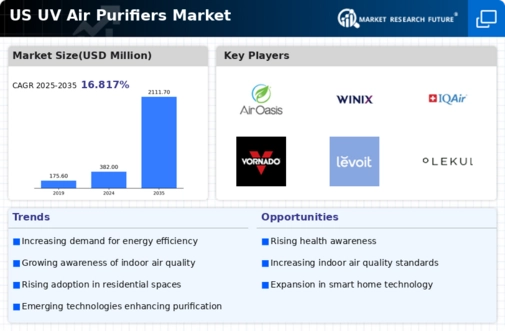Increased Indoor Air Quality Awareness
The growing awareness regarding indoor air quality is a pivotal driver for the uv air-purifiers market. As individuals become more cognizant of the health implications associated with poor air quality, the demand for effective air purification solutions rises. Studies indicate that indoor air can be up to 5 times more polluted than outdoor air, prompting consumers to seek out technologies that can mitigate these risks. The uv air-purifiers market is positioned to benefit from this trend, as these devices are known for their ability to eliminate harmful pathogens and allergens. Furthermore, the market is projected to grow at a CAGR of approximately 10% over the next five years, reflecting the increasing prioritization of health and wellness in residential and commercial spaces.
Rising Demand for Eco-Friendly Products
The shift towards eco-friendly products is becoming a significant driver for the uv air-purifiers market. Consumers are increasingly prioritizing sustainability in their purchasing decisions, leading to a preference for air purifiers that utilize environmentally friendly technologies. UV air purifiers, which do not rely on harmful chemicals or filters that require frequent replacement, align well with this trend. This growing demand for sustainable solutions is likely to propel the market forward, as manufacturers innovate to meet consumer expectations. The uv air-purifiers market could see a notable increase in market share, with estimates suggesting that eco-friendly products may account for over 30% of total sales by 2026.
Increased Urbanization and Pollution Levels
The rapid pace of urbanization and the corresponding rise in pollution levels are driving the uv air-purifiers market. As more individuals move to urban areas, the exposure to pollutants and allergens increases, creating a heightened need for effective air purification solutions. Urban environments often experience higher concentrations of particulate matter and volatile organic compounds, which can adversely affect health. Consequently, consumers are turning to uv air purifiers as a viable solution to combat these challenges. The market is expected to expand significantly, with forecasts indicating a potential growth of 15% in urban areas alone, as residents seek to improve their indoor air quality amidst rising environmental concerns.
Regulatory Support for Air Quality Standards
Regulatory frameworks aimed at improving air quality standards are significantly influencing the uv air-purifiers market. Government initiatives and policies that promote cleaner air in both residential and commercial environments are driving the adoption of air purification technologies. For instance, the Environmental Protection Agency (EPA) has established guidelines that encourage the use of air purifiers to combat indoor air pollution. This regulatory support not only enhances consumer confidence but also stimulates market growth, as manufacturers align their products with these standards. The uv air-purifiers market is likely to see an uptick in demand as compliance with air quality regulations becomes more stringent, potentially leading to a market expansion valued at over $1 billion by 2027.
Technological Innovations in Air Purification
Technological advancements in air purification systems are a crucial driver for the uv air-purifiers market. Innovations such as enhanced UV-C light technology and smart integration capabilities are making these devices more effective and user-friendly. The introduction of IoT-enabled air purifiers allows consumers to monitor air quality in real-time, thereby increasing the appeal of these products. As technology continues to evolve, the efficiency and effectiveness of uv air-purifiers are expected to improve, attracting a broader consumer base. The market is anticipated to witness a surge in sales, with projections indicating a growth rate of around 12% annually, as consumers increasingly seek out cutting-edge solutions for their air quality needs.























Leave a Comment